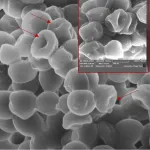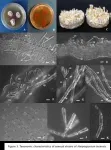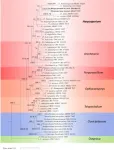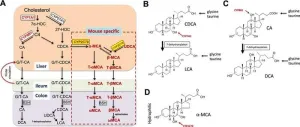(Press-News.org) A novel antibacterial lipopeptide produced by the bacterium Serratia marcescens has been shown to be highly effective in killing Staphylococcus aureus – one of the most important pathogens occurring in humans.
Staphylococcus aureus is one of the five most common causes of hospital-acquired infections and is often the cause of life-threatening infections following surgery. Since the introduction of antibiotics in the early 1940s, S. aureus has by now developed resistance against most classes of antibiotics, including penicillin. However, over the last six decades, only two new classes of antibiotics with unique modes of action have been introduced onto the market. One of these, daptomycin, also belongs to the lipopeptide class of antibiotics.
In a paper published in Microbiology Spectrum recently, Dr Tanya Decker (neé Clements) from Stellenbosch University (SU) provided the first insight into the mode of action of the lipopeptide serrawettin W2-FL10, derived from Serratia marcescens. She demonstrated that this lipopeptide targets the cell membrane of S. aureus, causing lesions which result in the leakage of intracellular components and ultimately cell death.
She also demonstrated that serrawettin W2-FL10 is not toxic to mammalian cells, thereby making it a promising therapeutic agent for the treatment of bacterial infections in humans.
Furthermore, as this lipopeptide’s structure is much smaller than that of daptomycin (five amino acids and a C10 fatty acid chain compared to 13 amino acids and a C10 fatty acid chain), the manufacturing costs of serrawettin W2-FL10 would be significantly less.
Why are some lipopeptides antimicrobial?
Dr Decker, who is currently a postdoctoral researcher at the Helmholtz Institute for Pharmaceutical Research Saarland in Germany, started working on serrawettin W2-FL10 back in 2017 in the research group of Prof. Wesaal Khan in SU’s Department of Microbiology. Her research followed the work done by another postgraduate student in this group, Dr Thando Ndlovu, who isolated various bacterial strains from wastewater samples whose biosurfactants proved effective against antibiotic-resistant and disease-causing bacteria. In polluted environments, biosurfactants are produced naturally by bacteria to protect them against and outcompete other bacteria.
Decker’s research then focused on understanding the antimicrobial activity of Serratia-derived lipopeptides. She focused primarily on pigmented and non-pigmented S. marcescens strains and demonstrated that these strains also produced a wide range of broad-spectrum antimicrobial compounds. From these findings, the lipopeptide serrawettin W2-FL10 was found to be a promising candidate for further investigation into its antimicrobial characteristics.
Prof. Khan says the success of their findings thus far is also largely based on close collaboration with Prof. Marina Rautenbach, a biochemist and specialist in antimicrobial peptides, at SU’s Department of Biochemistry.
At the Helmholtz Institute in Germany, Decker is continuing her research into novel natural antimicrobial products.
END
Novel lipopeptide proves lethal against Staphylococcus areus
A novel antibacterial lipopeptide produced by the bacterium Serratia marcescens has been shown to be highly effective in killing Staphylococcus aureus – one of the most important pathogens occurring in humans
2024-06-06
ELSE PRESS RELEASES FROM THIS DATE:
Harposporium incensis sp. nov., a South American cordycipitoid species exhibiting inter-phylum host-jumping and having potential as a biological control agent for pest management
2024-06-06
The genus of Harposporium belongs to the Ascomycota of the Fungi kingdom, the class Sortariomycetes, the order Hypocreales, and the family Ophiocordyceiaceae, is a common genus of soil fungi. The species of Harposporium are pathogens of nematodes, with some also infecting rotifers or tardigrades, and has significant ecological value. In recent years, studies have shown that a few species of the genus Harposporium can also parasitize insects or other invertebrates, such as H. janus, which can infect beetles in the Coleoptera family. However, so far, it has not been found that the same species in this genus can parasitize different invertebrates in both sexual and asexual stages. Is there a ...
Balancing act between digestion and liver health through bile acids
2024-06-06
Bile acids are essential molecules the liver produces that play a critical role in digestion. They help us absorb fat-soluble vitamins and cholesterol from our food. However, bile acids can become a double-edged sword. While they are necessary for proper digestion, high concentrations can also be toxic to the liver.
Recent research is shedding light on the complex relationship between bile acids and liver health. Scientists have identified new ways in which bile acids interact with cellular stress responses, impacting how the liver functions in diseases ...
Cleveland clinic-led study links sugar substitute to increased risk of heart attack and stroke
2024-06-06
June 6, 2024, Cleveland: Cleveland Clinic researchers found higher amounts of the sugar alcohol xylitol are associated with increased risk of cardiovascular events like heart attack and stroke.
The team, led by Stanley Hazen, M.D., Ph.D., confirmed the association in a large-scale patient analysis, preclinical research models and a clinical intervention study. Findings were published today in the European Heart Journal.
Xylitol is a common sugar substitute used in sugar-free candy, gums, baked ...
Vigorous exercise may preserve cognition in high-risk patients with hypertension
2024-06-06
WINSTON-SALEM, N.C. – June 6, 2024 – People with high blood pressure have a higher risk of cognitive impairment, including dementia, but a new study from researchers at Wake Forest University School of Medicine suggests that engaging in vigorous physical activity more than once a week can lower that risk.
The findings appear online today in Alzheimer’s & Dementia: The Journal of the Alzheimer’s Association.
“We know that physical exercise offers many benefits, including lowering blood pressure, improving heart health and potentially delaying cognitive decline,” said Richard Kazibwe, ...
Sanders-Brown study: Long-read RNA sequencing reveals key gene expressions in Alzheimer’s disease
2024-06-06
LEXINGTON, Ky. — Researchers at the University of Kentucky Sanders-Brown Center on Aging are working to develop a pre-symptomatic disease diagnostic tool for Alzheimer’s disease.
“While the need for better treatments is clear, such treatments will not be very meaningful if they are administered after symptoms have onset. By then, Alzheimer’s disease has been ravaging the brain for decades to the point the brain can no longer compensate for the extreme cellular death,” said Mark ...
Women with excess weight as a teen or young adult may have higher stroke risk by age 55
2024-06-06
Research Highlights:
Women with excess weight at age 14 or 31 may have increased ischemic (clot caused) stroke risk before age 55. The same ischemic stroke risk was not found in men.
Losing excess weight after adolescence may not eliminate the stroke risk.
These findings are according to a study conducted in Finland that followed more than 10,000 people from birth into their 50s.
Researchers suggest health care professionals pay attention to overweight and obesity in young people and work with them to promote healthy eating and physical activity from an early age.
Embargoed ...
New glioblastoma treatment reaches human brain tumor and helps immune cells recognize cancer cells
2024-06-06
· Major advance for treatment of deadly brain cancer
· Clinical trial launched at Northwestern to test treatment
· Ultrasound microbubbles open blood-brain barrier to admit chemotherapy and immunotherapy cocktail
CHICAGO --- In a major advance for the treatment of the deadly brain cancer glioblastoma, Northwestern Medicine scientists used ultrasound technology to penetrate the blood-brain barrier and provide a small dose of a chemotherapy and immunotherapy drug cocktail. The study found that this treatment ...
Using oceanography to understand fronts and cyclones on Jupiter
2024-06-06
New research led by Lia Siegelman, a physical oceanographer at UC San Diego’s Scripps Institution of Oceanography, shows that the roiling storms at the planet Jupiter’s polar regions are powered by processes known to physicists studying Earth’s oceans and atmosphere. The geophysical commonalities spanning the 452 million miles between the two planets could even help facilitate an improved understanding of those processes on Earth.
Siegelman first made the connection between our planet and the gas giant in 2018 when she noticed a striking similarity between images of Jupiter’s huge cyclones and the ocean turbulence she was studying. ...
Ohio State develops searchable database for Alzheimer’s research
2024-06-06
COLUMBUS, Ohio – A searchable database is now ready to help study Alzheimer’s disease.
Neuroscience and biomedical informatics researchers at The Ohio State University Wexner Medical Center and College of Medicine created the comprehensive, user-friendly repository.
The free database – known as ssREAD – is outlined in a manuscript published online in Nature Communications.
Alzheimer’s disease is the most common cause of dementia, accounting for up to 80% of cases. An estimated 6.7 million Americans who are age 65 and older are living with Alzheimer's dementia today, according ...
Lifesaving childbirth blood loss intervention is highly cost-effective
2024-06-06
Economic analysis of the E-MOTIVE trial finds that average cost per patient of drape and treatment to save women’s lives incurs minimal additional cost compared with usual care, while significantly improving health outcomes.
The additional cost to achieve the improved outcome could be as little as 30 US cents extra- on average, compared to usual care.
Post-partum haemorrhage currently affects 14m women around the world and leads to 70,000 deaths a year which is equivalent to one woman dying every 6 minutes
A lifesaving package including early detection and bundled treatment for ...
LAST 30 PRESS RELEASES:
Why nail-biting, procrastination and other self-sabotaging behaviors are rooted in survival instincts
Regional variations in mechanical properties of porcine leptomeninges
Artificial empathy in therapy and healthcare: advancements in interpersonal interaction technologies
Why some brains switch gears more efficiently than others
UVA’s Jundong Li wins ICDM’S 2025 Tao Li Award for data mining, machine learning
UVA’s low-power, high-performance computer power player Mircea Stan earns National Academy of Inventors fellowship
Not playing by the rules: USU researcher explores filamentous algae dynamics in rivers
Do our body clocks influence our risk of dementia?
Anthropologists offer new evidence of bipedalism in long-debated fossil discovery
Safer receipt paper from wood
Dosage-sensitive genes suggest no whole-genome duplications in ancestral angiosperm
First ancient human herpesvirus genomes document their deep history with humans
Why Some Bacteria Survive Antibiotics and How to Stop Them - New study reveals that bacteria can survive antibiotic treatment through two fundamentally different “shutdown modes”
UCLA study links scar healing to dangerous placenta condition
CHANGE-seq-BE finds off-target changes in the genome from base editors
The Journal of Nuclear Medicine Ahead-of-Print Tip Sheet: January 2, 2026
Delayed or absent first dose of measles, mumps, and rubella vaccination
Trends in US preterm birth rates by household income and race and ethnicity
Study identifies potential biomarker linked to progression and brain inflammation in multiple sclerosis
Many mothers in Norway do not show up for postnatal check-ups
Researchers want to find out why quick clay is so unstable
Superradiant spins show teamwork at the quantum scale
Cleveland Clinic Research links tumor bacteria to immunotherapy resistance in head and neck cancer
First Editorial of 2026: Resisting AI slop
Joint ground- and space-based observations reveal Saturn-mass rogue planet
Inheritable genetic variant offers protection against blood cancer risk and progression
Pigs settled Pacific islands alongside early human voyagers
A Coral reef’s daily pulse reshapes microbes in surrounding waters
EAST Tokamak experiments exceed plasma density limit, offering new approach to fusion ignition
Groundbreaking discovery reveals Africa’s oldest cremation pyre and complex ritual practices
[Press-News.org] Novel lipopeptide proves lethal against Staphylococcus areusA novel antibacterial lipopeptide produced by the bacterium Serratia marcescens has been shown to be highly effective in killing Staphylococcus aureus – one of the most important pathogens occurring in humans









